 April/May 2022 - Vol. 35, No. 6.
April/May 2022 - Vol. 35, No. 6.
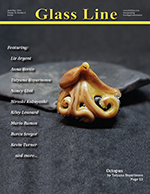
|
In This Issue
Encased Amanita Mushroom by Burcu Sevgor
Amanita muscaria has always been the Super Mario mushroom for me. For many others, they were the Smurfs’ homes. As one of the most widely known in popular culture, they are also one of the most poisonous. From Renaissance paintings to Alice’s Adventures in Wonderland, they are the devils in the details and the gates to other consciousness...

I was strictly a soft-glass artist until 2020, when during one of our lockdowns, I took an online course in borosilicate glass — making glass chains, to be exact. I’m still learning the intricacies of working with boro, but enjoy the challenge and the added dimension it gives to my work.
Designing necklaces, earrings, bracelets, and pendants is such a gratifying experience when I am able to use my own unique lampwork creations. There is something so satisfying when you can market your pieces as truly one-of-a-kind. I feel that in the past 10 years, I have grown and continue to grow and evolve as an artist...
Octopus by Tatyana Boyarinova
To create this octopus you don’t need a lot of colors and tools.
When you start working, you should know what you’re going to get in the end. For example, if it’s earrings, you work with smaller size pieces of glass because of the weight. For home decoration, a bigger size is nicer...
Lattice Technique Elephant by Anna Bertle
This technique is a wonderful way to create something three-dimensional that never loses its lightness and delicacy.
You need a clear definition of the body parts of the animal to be made. Make sure that the sketches of the sides are consistent in dimension or size as the sketch from the front. They should be graphic and as minimalistic as possible...

Glass is beauty and color and light; fluid frozen in time. The wonder of nature provides me with endless inspiration: the grace of birds, the beauty of flowers, the sacred spaces under the trees. In the deep freeze of winter, I can craft gardens in glass, evoke walks on the seashore, and sculpt the visitors to my birdfeeders. In this way, I stay close to the things I love, even when they are not available. I live in beauty every day.
Ribbon cane is a great technique for making surface decoration because it allows for excellent retention of detail, leaving a sharp, crisp image. I learned this technique from Corina Tettinger’s Rainforest Beads online class. Here it is used to create the petals and leaves of the bird of paradise plant...

Glass Distractions started in 1996 when Kevin and Jenee’s passion for glassblowing became a way for them to continue doing what they love: making art from glass. Kevin and Jenee, both native to California, began their glassblowing journey in Berkeley. They learned the foundation of their skills blowing glass in their home. Through hard work, perseverance, and an unwavering adoration for torch work, they have had their artwork in the hands of people from Japan to Costa Rica. Now located in San Marcos, California, the two are in front of their torch nearly everyday while parenting a son and a daughter, and running a storefront. They are always continuing to hone the skills of their craft to share their visions of the most distracting glass art they can...

Although most of my learning was self-taught, I completed my training with various courses and workshops at the Royal Crystal Factory of Segovia, at Corning, and in Venice.
I love nature and much of my work is inspired by it — that’s why I make insects, birds, all kinds of animals and flowers — but I don’t like to tie myself to just one type of piece. I enjoy dabbling in the wide range of possibilities that a material as versatile as glass offers.
This tutorial is about how to make a perfume bottle with two colors, but keep in mind that it is always good to rethink creations in terms of colors and shapes to improve our designs...

Previously, I saw a TV program about producing an Apple Pendant, which has become one of my works. It has given me a lot of connections to many people and was an important experience.
I am always inspired by the nature-rich land of Aomori. Recently, I have been making works with flower buds as a motif. I am fascinated by its vitality....
Bubble Cap “Blow-out” Technique by Kiley Leonard
This article describes how to use the “blow-out” technique to mix colors and patterns in the process of building bubble caps. I’ve always been drawn to abstract art, so I fell in love with the color-blending properties of blow-outs. Striking colors tend to work best for creating unique textures and patterns...
|
 February/March, 2022 - Vol. 35, No. 5.
February/March, 2022 - Vol. 35, No. 5.
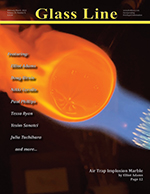
|
In This Issue

I got hooked on lampworking about 15 years ago. I’ve always loved working with glass and like so many, started with stained glass. Over the years, I tried steppingstones, mosaics, and fusing. I work mostly in soft glass and occasionally in boro, and teach beginning lampworking at my studio.
I’m always looking for inspiration. Friends sometimes ask if I can make this or that, and it is fun to make new things in the torch in response. I also do woodturning and am always looking for projects that combine both loves. For example, a friend recently helped me turn my lampworked components into fused lids for my wooden potpourri bowls.
When I attend lampworking classes, I usually bring my own mandrels because I coat them in the middle instead of on the end. I always get the comment, “You’re one of those people.” I know there are others out there like me because I’m one of those. My first lampworking instructor taught me on center-coated mandrels. Now I teach this technique to my beginning students...

Whenever I have the opportunity, I try to learn new things and improve myself by participating in national and international organizations, biennials, and workshops. I attended the Glass Fashion Show at the Corning Museum of Glass in June 2016 with my poppy dress. Recently, I took part in the Glass Fashion Show that was held for the first time this year during the International Denizli Glass Biennial, which is Turkey’s only glass biennial. Currently, I continue to produce and learn in my workshop in Izmir, Turkey.
This tutorial has two stages.
The first stage is to prepare the rose murrini. The second stage is to apply it to the cabochon mandrel...

This airtrap implosion pendant project shows that airtraps are quite fun and have the ability to emphasize the fluid nature of glass. I was shocked to learn that air inclusions are often considered undesirable in glass. The saying “Art is in the eye of the beholder” rings especially true in the borosilicate glass world. While some pieces, styles, and techniques consistently get good reactions from different audiences, I have found collectors to have incredibly different tastes and oftentimes appreciation for the opposite attributes of a piece. In my relatively short time on the torch, I have seen my preferences shift away from what attracts naturally and toward that which I have been influenced to appreciate by the glass world.
Sometimes this shift has proven helpful and assisted me in honing my skills and having more pieces survive the kiln, but I actively fight it and try to maintain the “glass appreciation eye” of a collector who hasn’t been affected by the preferences of the industry. This has been incredibly rewarding as I show my work to different audiences and consistently find that the aspect of a piece that they appreciate the most is something that may be undesirable or avoided in the boro world. Examples of these aspects include airtraps, scuzzing, and checking. More often than not, I avoid all of these unless it is intentional, but I have only reached this understanding of when to go for these effects intentionally by trial and error, and knowledge shared with me by other artists.
This seems like the perfect opportunity to share this view with the community and encourage other artists to make what they find beautiful and their collectors/audiences desire, not what the industry says should or shouldn’t be made. This demo marble contains an encased stringer color that results in a fuzzy effect I love, an outer color that “checks” in a really cool way, and some airtraps to pay homage to my foundation...

I’ve been lampworking since 2003, with an emphasis on silly 3-D cartoons. The sheep debuted early in my repertoire, with other animals gradually joining the collection. They’re a collection of dots, manipulated and shaped into an inquisitive sheep. I use much of the creation process in crafting my other beads...
Tube Pull Tutorial by Doug Birnie
Over the years, I’ve learned to try not to stress about making a piece. It helps to just go with the flow. Glass is forgiving. It’s important not to try to control it; sometimes it’s going to do what it wants to do. The most important thing I’ve learned blowing glass is not to force it. For instance, when condensing the wigwags on a linework section, just let the flame do the work for you; don’t push it together.
Here are my tips for a tube pull...

I live in a small town on the southern Oregon coast and am fortunate enough to wake up and work with glass every day. The seclusion of a rural area during a pandemic gave me the rare opportunity to fully throw myself into the art and make this my main focus. I can see that others took advantage of this time as well. Now we have the inspiration from each other to look forward to.
This tutorial demonstrates how to create a marbled effect by using the “rubber-band method” ...

First, preheat the lined tubing. This will help to prevent any cracking from flame introduction. After about 10 minutes, take out the tubing and tear it open if need be, clean it off, or cut it with a necking tool. After cleaning any bubbles or bubbles off the end of the tube, use one of the prepped blowtubes to attach to the open end of the lined tubing and melt in the connection a bit. Make this connection strong because it will have to cool a bit during the wig-wags ...
|
 December/January, 2021/22 - Vol. 35, No. 4.
December/January, 2021/22 - Vol. 35, No. 4.
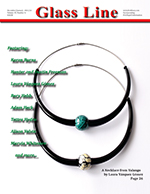
|
In This Issue
Bowtie Window Pendant Demo by Marvin Whitmore
I’ll never forget the first time I saw a mushroom marble in the early 1990s. It looked so real that I wondered how they got glass around it without ruining it (later I would learn it was Green Exotica). I knew that I wanted to learn this sorcery. Fortunately for me, the pipe industry took off in my town in the mid 1990s. A couple years later, a friend started working at a production pipe shop and got me a job there. That was how I got my foot in the flameworking door.
This demo is of a multi-sectioned bowtie window pendant made from Goldengate Glass Forest Fire lined tubing...

My surroundings inspire me. Living in the shadow of the Blue Ridge Mountains in North Carolina, being surrounded by waterfalls, nature influences me more than anything. When I’m not in the glass studio, I spend time in the forest, picking edible mushrooms or on a mountain digging up gemstones. When I’m in the studio, I enjoy making creatures, plants, and fungi to go on or in my functional pieces. My favorite creations are collaborations with my husband and shopmate, whose company is Whiskey Fire Glass.
The sea turtles I make remind me of my hometown by the ocean. Glass turtles are quite popular for good reason. In many cultures, sea turtles have meaning: longevity, peace, grounding, ancient wisdom, and emotional strength. Turtles are also known as timekeepers because they carry the lunar calendar on their backs in their shell patterns. Many amazing turtles made from glass are out there, but here is my unique technique to make sea turtles...

During my years of working with glass, I have been privileged to study on Murano and have done classes with Loran Stump and Corina Tettinger. A variety of kind souls answered questions in forums like Wet Canvas, and I thank them all. One of the nicest things about the worldwide lampwork communities is the kindness and helpfulness I have experienced.
I see myself as a dedicated romantic, expressing my love of life through my art, and one of my major pleasures is to make people smile...

I am the owner of Locanda Studio in Mendon, Massachusetts. I became hooked on glass beadmaking from the very first time I melted a rod in an introductory class in Atlanta years ago. A few years ago, I decided to take this obsession to the next level, and built my very own bead and jewelry production and teaching studio. My other passion is gardening, and from my studio, I have a view of my wildflower pollinator garden, an inspiration for what I call Garden Beads.
Note: In this Tutorial I use hard glass to explain
...

Carving glass is a repetitive task that takes constant focus to ensure consistency in patterns. The human eye is so astute at pattern recognition that a cut that is even a few hundredths of a millimeter too shallow, deep, long, etc., can be noticed. This means the most important part of cold-working is to stay constantly present and in the moment. The meditative nature of the craft may be one of its most enjoyable aspects.
This tutorial presents the process of creating a marble using a signature design ethos that I have implemented in my recent works. It involves marbles with highly polished facets, lathe engraving, inlays, and sandblasting. By incorporating these design elements into a single piece, a simple clear marble can be turned into a piece with different optics and patterns, depending on the angle of view. This creates a near-infinite variety of patterns that can be seen in the piece as it is rotated.
This project assumes the reader has some basic knowledge about using a faceting machine and using the angle, index, and facet number pattern, and an engraving lathe and carving wheels...
-Recuperado.sm.jpg)
The torch lets me modify the raw material — rods of different colors, opacity, and thickness — until I obtain the final piece, all in the same action, including several movements and gestures. It’s like a dance. Mastering the technique is key here, but chance and improvisation play an important role, resulting in forms that escape absolute control. Although not perfect, these jewels are unique; they have their own personality, their own soul.
Another technique I use is fusing: After cutting the glass, the different elements come together at high temperatures and fuse into a single piece, inseparable from its parts. It is a long and less-spontaneous process, where a temperature curve is involved (more or less complex, depending on the architecture of the piece), but where other types of appealing objects can be created using profusions or elements previously worked on the torch...

We decided we wanted a thick, sturdy pipe that was colorful, interesting to look at and an overall look and feel to each pipe that was recognizable as a Skunk Ape pipe.
We took our pipes to the local hemp dispensary and asked for shelf space. They gave us a spot in their store, and we have been grinding it out every day, making spoon pipes, pendants, and marbles; learning new techniques and how to make other styles of pipes.
The advancement of our craft is our plan. Making functional glass art for the community is our passion....

I owe much of my success to Revere Glass — my skills and technical knowledge were greatly accelerated due to Dustin Revere’s help. I focused on the basics, making blanks and learning different marble techniques, and found that I loved making unique tubing. This is what led to my current interest in making holiday ornaments. The large effort of making a tube and turning the whole thing into one piece was very satisfying.
Here is how I make one of my favorite designs...
|
 October/November, 2021 - Vol. 35, No. 3.
October/November, 2021 - Vol. 35, No. 3.
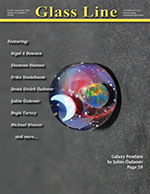
|
In This Issue
“Chocolate” Easter Bunny by Shannon Hanson
Easter is a lot a fun for my family. My love for the hollow chocolate Easter bunny is undeniable and my wife is certain to provide me with a variety every year. A lot of my work is influenced by my Christian faith, so I thought it would be fun to create a “chocolate” Easter bunny out of glass. After a lot of thought, I considered re-purposing antique chocolate molds for glassblowing purposes. Low and behold, it worked! You can find a variety of chocolate molds (eBay is a great source), and the possibilities with this technique are equally diverse
...

I believe that the learning process of glass is never-ending. I do my best to learn something new every day.
Nature inspires me. That is why I love making murrini and reflecting the colors and themes of nature in my works. I use murrini to design flower gardens, colorful landscapes, vivarium, and galaxy beads. For the past year, I have been making beads and marbles with colored dots and the implosion technique for my new collection, which I call Cocoon
...

In 2014, we decided to sell our house and move to the north of the Netherlands. That was the end of my public studio. I did have a lot of fun teaching the art of making glass beads, but I needed time and space for my own creative glass journey. We bought an old farmhouse and made a studio for me in the house. It’s a perfect happy place for me. I work on a Bobcat torch with a 10 lt oxygen concentrator. I am fortunate to have a natural gas pipeline that goes directly into my studio, so all I have to do is flip a switch and the gas flows straight into my burner.
I love being in my studio, working with my favorite components: Double Helix glass, dichroic, cubic zirconia, glam glitter, goldstone — all the stuff that sparkles. Many people do not dare to work with silver glass because of the high price. Let yourself try this glass and mess it up — every botched project gives you so much knowledge and eventually you will succeed. The journey is part of your future success
...

I was born in Ankara, Turkey, in 1984. My father is a glass artist who creates designs using cold glass techniques. Thanks to all the time that I spent in his workshop throughout my childhood, I learned the particulars of working with cold glass. Since then, one way or another, my life has been intertwined with glass. In 2013, I left my full-time job and opened a lampwork studio. I started making decorative products using the glassblowing technique within a couple months
...
Wine Glass Demo by Michael R Weaver
This tutorial shows how to make a glass icicle as a gift or a reminder that those unbearably hot days in the summer won’t last forever.
Note: In this Tutorial I use hard glass to explain
...
Dichroic Image and Opal Tricks by Regis Turocy
I wanted to share how to skin opals and place them precisely behind dichroic glass. Obtaining the right placement of the opals and thickness of glass allows for the opal’s shape and colors to stay closer to the surface of the dichroic glass patterns. This can also be magnified, or not, at the end of the cab or pendant construction.
This hyper-focused technique and look reinstated a lot of the old magic of the whole glass process for me. I got into the use of opals as well and all of Profound Glass’s and Dichroic Alchemy’s assorted inventory. The colors and depths that can be altered with this whole process can be limitless.
These make great pendants and accents for larger works
...

My work today largely consists of inside-out pipes filled with dichroic filigrana, latticinos, gold and silver fume, and dot work. I also love to make my own vac-stacked tubing, dichroic tubing, hand-mixed colors, sleeving, and stringer drawing. Smoking accessories pay my bills, but I also love making ballerinas, angels, demons, and many other forms of classical and modern sculpting. I also find goblets both confounding and fascinating ...
I always give the same advice to new glassblowers: Keep going and don’t give up. It will get easier and your pieces will stop cracking. Don’t be afraid of a big, bushy flame — the Bunsen burner is your best friend
...
|
 August/September, 2021 - Vol. 35, No. 2.
August/September, 2021 - Vol. 35, No. 2.
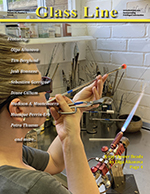
|
In This Issue
X-ray Flower Beads by Olga Alianova
I watched and read every tutorial which I could find and after three years, I made a trip to Murano, Italy, where I learned the techniques of blowing soft glass. These techniques captured my imagination completely. They offered endless possibilities to create something absolutely different from what I had been doing with glass before.
Colored soft glass behaves very differently when it’s blown. Through experimentation, I able to surprise myself with the beautiful colors and patterns that emerged. I continuously test new glass to see how the colors transform during the heating, blowing, and cooling processes.
I’m still growing in my skills and can’t wait to see where glass will take me.
This tutorial is about how to create a soft glass murrini bead using White Thomson enamel. Once blown on the torch, it transforms into a delicate floral and lace pattern that reminds me of X-rayed flowers ...

Back in Alsace, I was looking for a way to create work beyond the usual manufacturing standards of a glassblower. I discovered a workshop in making glass beads with a blowtorch, organized by the Museum of Glass at Sars Poterie, a small commune in northern France. I launched my own glass workshop with a blowtorch in 2004. I now have a workshop at my home, in the village of Heimsbrunn, and I own a shop in Mulhouse. I also have an online shopping site and am a member of the Association des Perliers de France.
I use implosions with twisted cane (with soda-lime glass) to make beads and pendants...

Glass has taken me to places I never dreamed I’d go. Like Japan. Twice. I have glass in the Paul Rusche Museum in Kiyasato. I met fellow lampworkers when I was demonstrating in Japan. I’ve designed and built glass lamps for private Frank Lloyd Wright homes. I’ve spoken glass with people in so many languages. Glass is the translator. It brings us together. And after 10 years, I have still only begun to understand it. It challenges me on a daily basis. Every day is a lesson in glass and myself.
Focus is key. Use only as much heat is required. Have fun and keep yourself centered.
The two-sided pink tree bead is a standard of mine. I love trees. Always have. Always will. I consider them the watchers of our world because they live so much longer than we do. I’ve seen a tree at a shinto shrine in Japan that is 1,000 years old. One thousand years old!
I’m a horticulturist so of course, I love flowers, too. And since a flat bead has two sides, I decorate both. Usually the front has the tree and the back is a flower scene.
The background can be whatever you want.
I love reactive glass and dichroic glass, so I use a lot of that in my beads. I also love fine silver sheet in transparent beads. It lends such a nice sparkle, and it looks gold with some glass, such as Clio layered over it.
Large focals are my favorite beads to make, but you have to constantly reheat the whole bead or you’ll lose it to cracking...

I mainly use Effetre, CIM, and Reichenbach. My burner is a Minor coupled with a 5 liter oxygen concentrator. I generally make single beads, which I turn into jewelry with silver and stainless steel components. I also like to make memory beads: pet hair beads, as a reminder of beloved four-legged friends. I enjoy trying new and different techniques. Occasionally I use borosilicate glass. Small animals in the form of module beads are another passion of mine.
In 2019, I set up a small shop. I also offer courses in this wonderful craft.
What fascinates me most about this great material are the endless possibilities...

I own Juba Glass and have been working as a professional lampwork borosilicate glass artist since 1996. I make all of my creations in my studio in Eugene, Oregon. I moved to the West Coast in 1995, at the age of 21, and set about studying the art of glass. Always looking to hone my skills and learn new ways of expressing myself, I have studied with several world-class contemporary glass artists. My works are now on display in galleries and private collections worldwide.
The focus of this article is to demonstrate how to use Ikonics Ultra Pro 3 mm photoresist film to create masks to use in carving and sandblasting glass artworks...

I have shared my love of glassblowing with my wife and five daughters. Even some of the grandkids have learned the skill. Everyone in the family has been involved in some aspect. I’ve demonstrated this hobby for elementary to college students, as well as Girl Scout troops and anyone who has asked to watch. The family has enjoyed displaying and selling our glass items at vendor shows and consignment shops in Estes Park and Evergreen, Colorado, and Winthrop, Washington. I have displayed my work and entered in local art competitions. The hobby has helped me earn a little extra car money — my other hobby is restoring old cars.
It has been nearly 30 years since I fulfilled my childhood dream of becoming a glassblower. Being self-taught, it took a lot of trial and error to learn the art of lampworking. At the same time, being self-taught has allowed me to develop my own personal style and methods...

Every bead I make starts as a disk and my Bravo torch starts the melting procedure while I add color and let gravity decide what will be produced. I have had no instruction apart from an introduction to lampworking class, so I learned through making all the errors. But every error was a learning curve, and it did not take long to realize that everybody works differently. Once you find your Zen, then it’s yours to own.
A tutorial is a tool for your jumping-off point to stretch your boundaries. For me, the best way to use tutorials is to take hints from several and blend them to make your bead. It will always surprise you when your beads are finally cooled and ready to be removed from the kiln.
This tutorial is meant for you to enjoy — add your touches to it so you can create a beautiful one-of-a-kind bead. By no means do you have to use all the ingredients. I have added several substitute colors. I use a light transparent base, but you can use any color you want. The pale pastels I use for the under the murrini or the flower dots are to make the colors pop or for the murrini to have a backing in case there is transparent color in the murrini. There is so much that you can change in this tutorial to make it your own Organic Garden Bead, such as adding silver leaf or foil, frit blend, silver glass frit reducing and/or striking frit; various flower style murrini, twisty, and so much more. Your imagination is the only thing that will limit the possibilities...

This project is for glassworkers who wish to create memorial objects from the ashes or cremains of a beloved person or pet...
|
 June/July, 2021 - Vol. 35, No. 1.
June/July, 2021 - Vol. 35, No. 1.
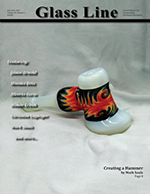
|
In This Issue
Fairytale Shard Beads by Monika Betz
I live with my husband, two kids and bulldog in a small village on the western region of Germany. I’ve always been fascinated by creative artworks and have always collected colorful stones and flowers to make my own jewelry. Over the years, I tried many creative outlets, such as drawing, sewing and jewelry design, until I finally found my true passion: glass.
I didn’t have the luxury of taking lampwork classes, so I paid my dues with many years of self-study before I felt comfortable with my results...

I’m focusing more on medium-size pieces now, and having fun working out different processes for making Sherlocks and hammers. I don’t do any production work at the moment. When I am behind the torch, I am constantly changing things up and trying to make the nicest piece possible. When you are pushing your shaping skills to the limit, patience is key. If it’s not what you want, give it some more heat and keep working it!
For the dry hammer described here, keeping the stem proportionally small enough is important. As a wise dude once told me, “Smaller is baller” ...

The turning point I had been waiting for came after my wife began to make glass beads. After some practice, I opened my own company, Cortestudioglass, in 2007, near the Arsenal in Venice. Seven years ago, I moved to Asolo in Treviso’s hilly territory, where I still live and work.
I studied many techniques regarding beads and developed a variety of styles for some dealers in Venice and Murano. Then I took advantage of an opportunity to learn how to blow hollow beads from glass master Paolo Cenedese in Murano, and watched some videos about furnace working and off-mandrel lampwork techniques with soft or boro glass, although I haven’t tried to work the latter one yet
...

I’ve been on the torch since 1999. I got started in Boulder, Colorado, and have traveled abroad to study and learn glass. This demo features a Veronese vase. While living in Italy and studying under Cesare Toffolo, I noticed that this shape was a Venetian symbol and traditional emblem. I have a mind, body, and spirit connection with glassmaking and the Renaissance-era glass. I hope this article will inspire you to search and practice these techniques. I still seek to learn all I can...
Flower Turtles by Jason Arnold
It always surprises me just how many people have some story involving a turtle to relay when they see my art. I never expected these little figurines to affect people they way they seem to at times, but I am happy to see the smiles and hear the stories that my turtles evoke.
Don’t be shy about making your own turtles. Make turtles just like mine. Post them. Make your own. Post those too. Make one. Make hundreds. Just have fun...

Teaching someone about the glass arts doesn’t just help people discover lampworking; it also leads me to research, improve, and consequently improve my own work.
It is always exciting to shape glass from its fluid form to its rigid and shiny form.
For about 10 years, I have been working with soft glass, creating lampwork beads; pulling canes and murrines; blowing glass with a pipe; and being passionate about creating a glass dip pen. I can apply many techniques that I have developed.
For this tutorial, I made a jellyfish pendant with soda-lime (COE 104) glass. The technique can be adapted to different kinds of glass, such as COE 33 or COE 90. All kinds of variations are possible. You can make a pendant or a decorative piece. Just experiment with it...
|
 April/May, 2021 - Vol. 34, No. 6.
April/May, 2021 - Vol. 34, No. 6.
|

